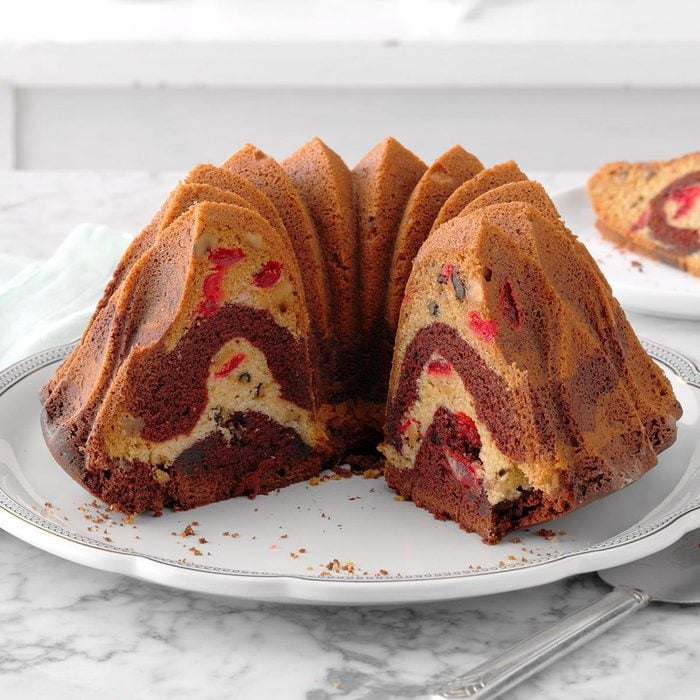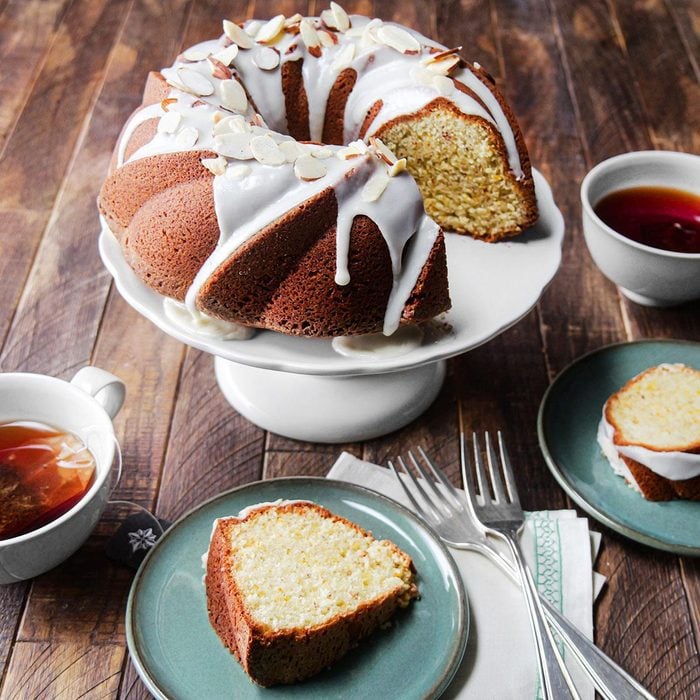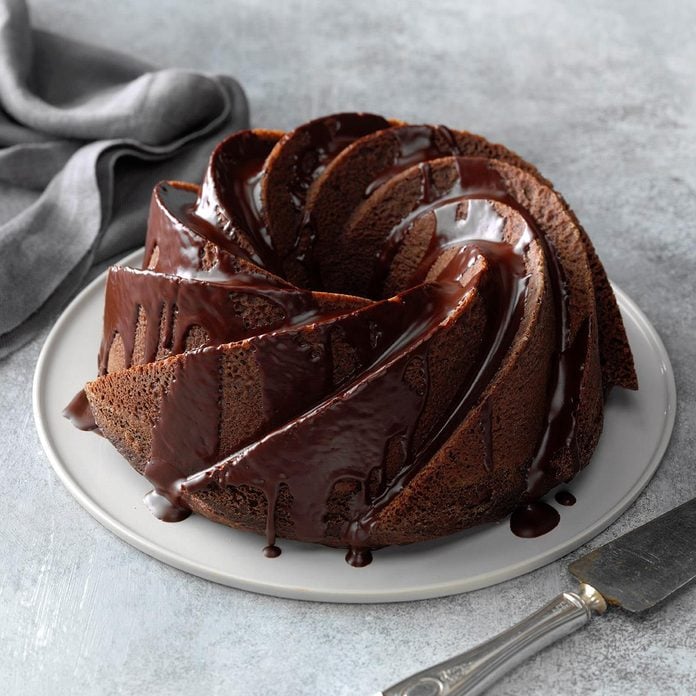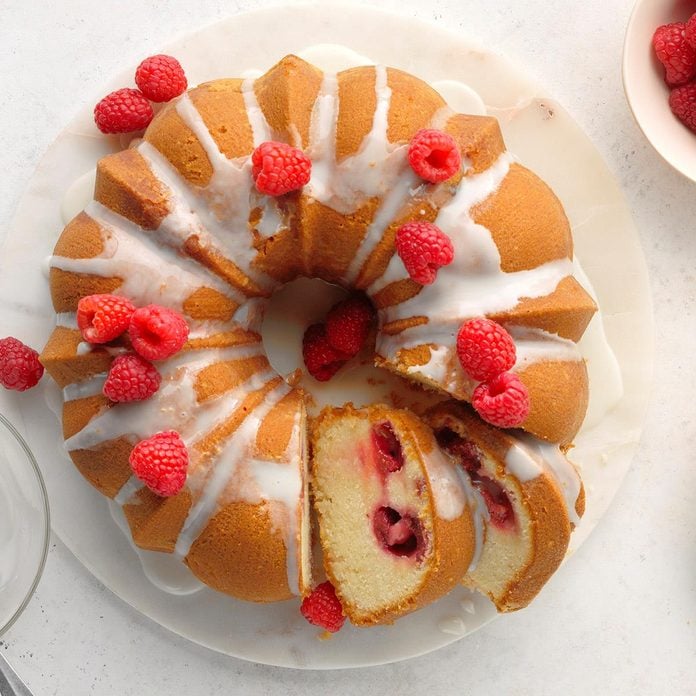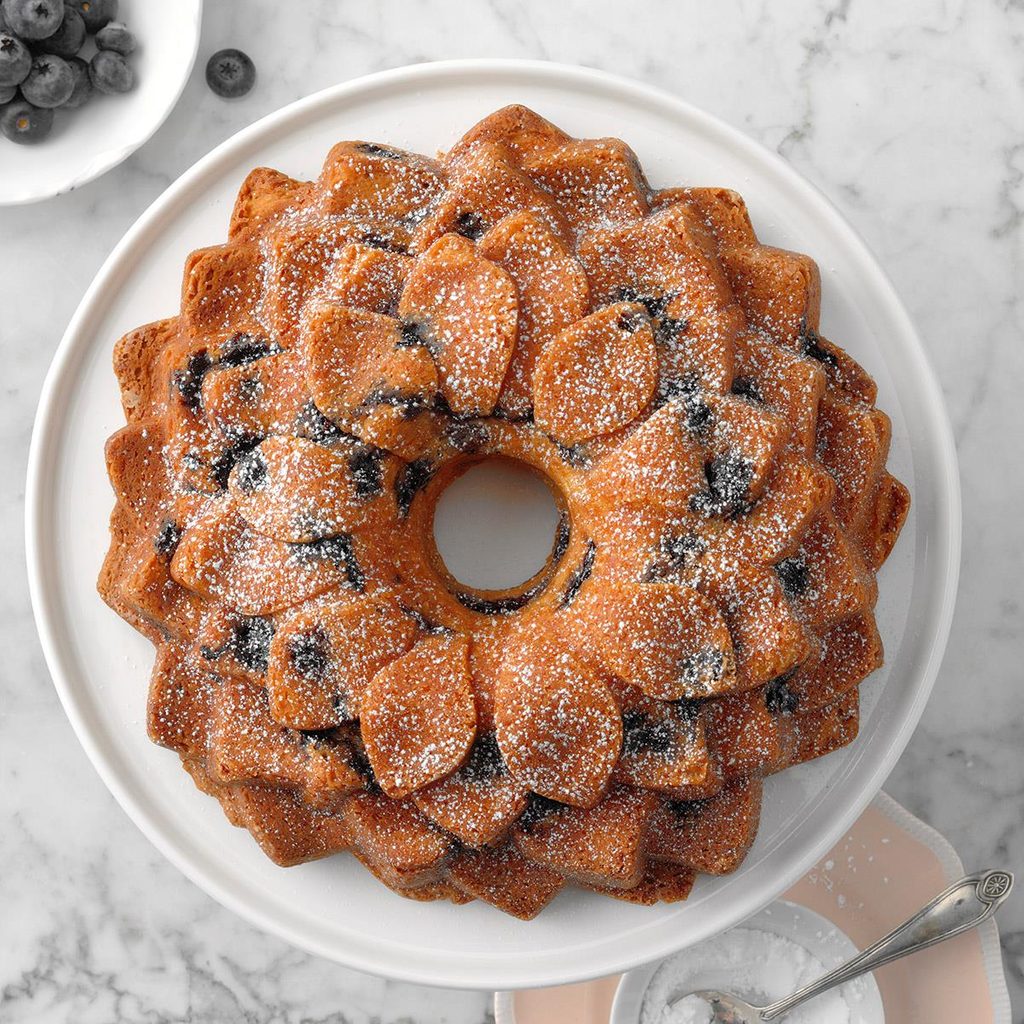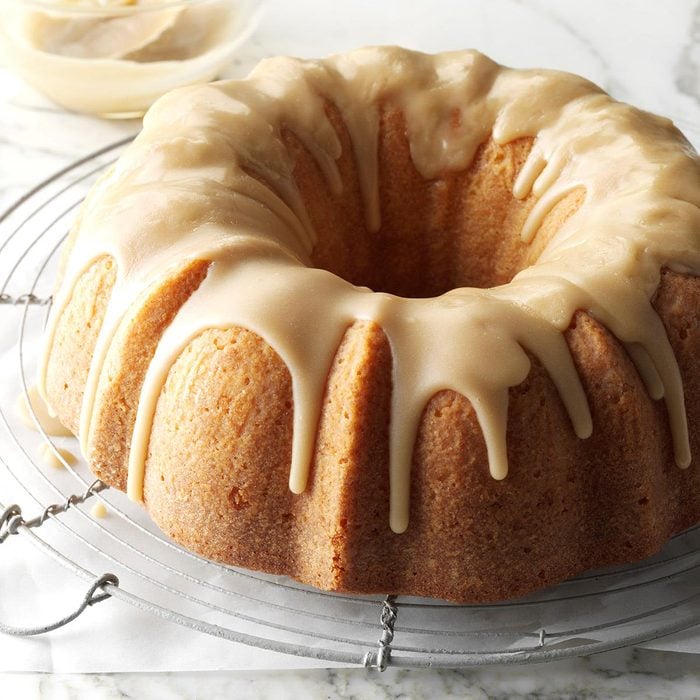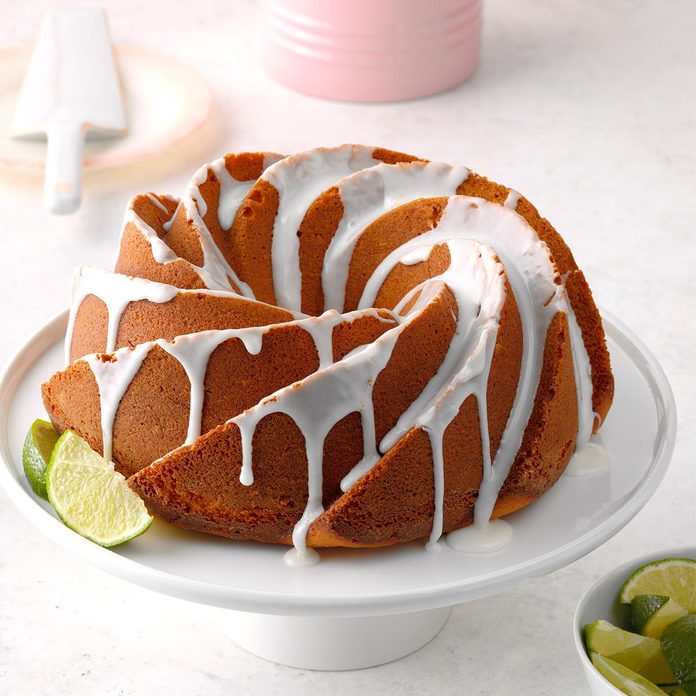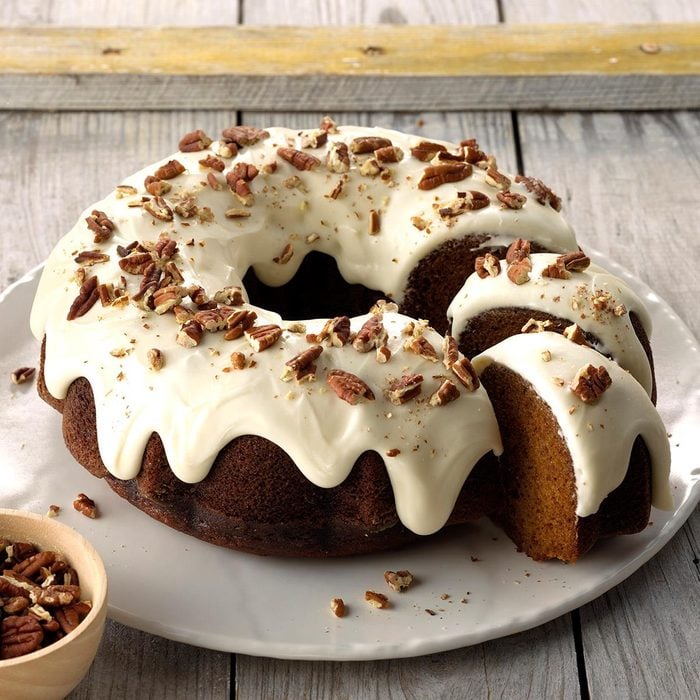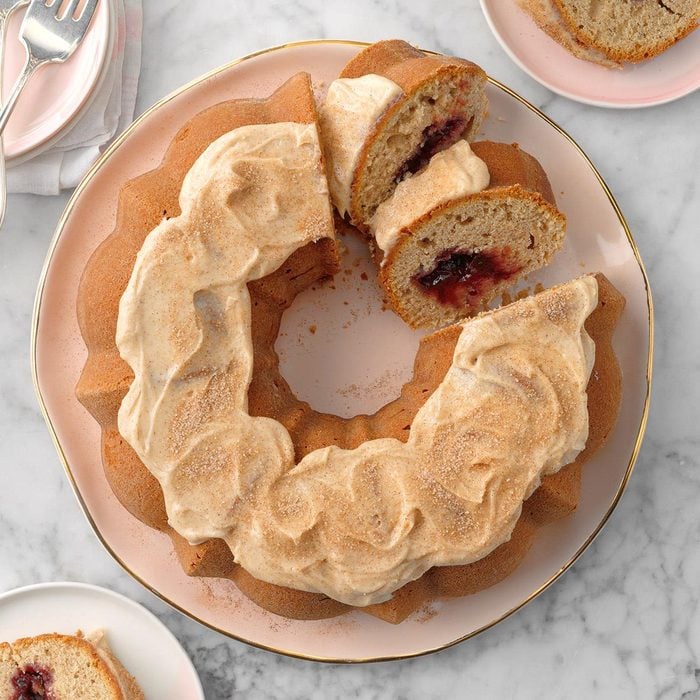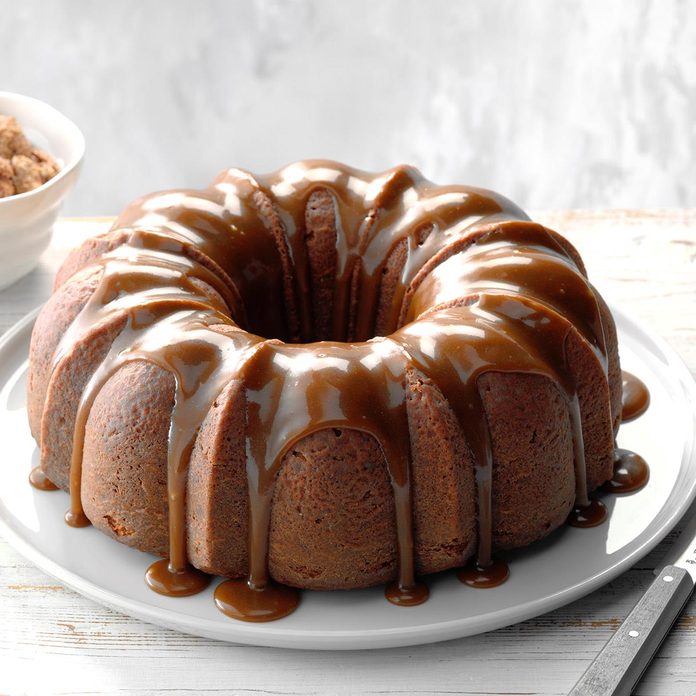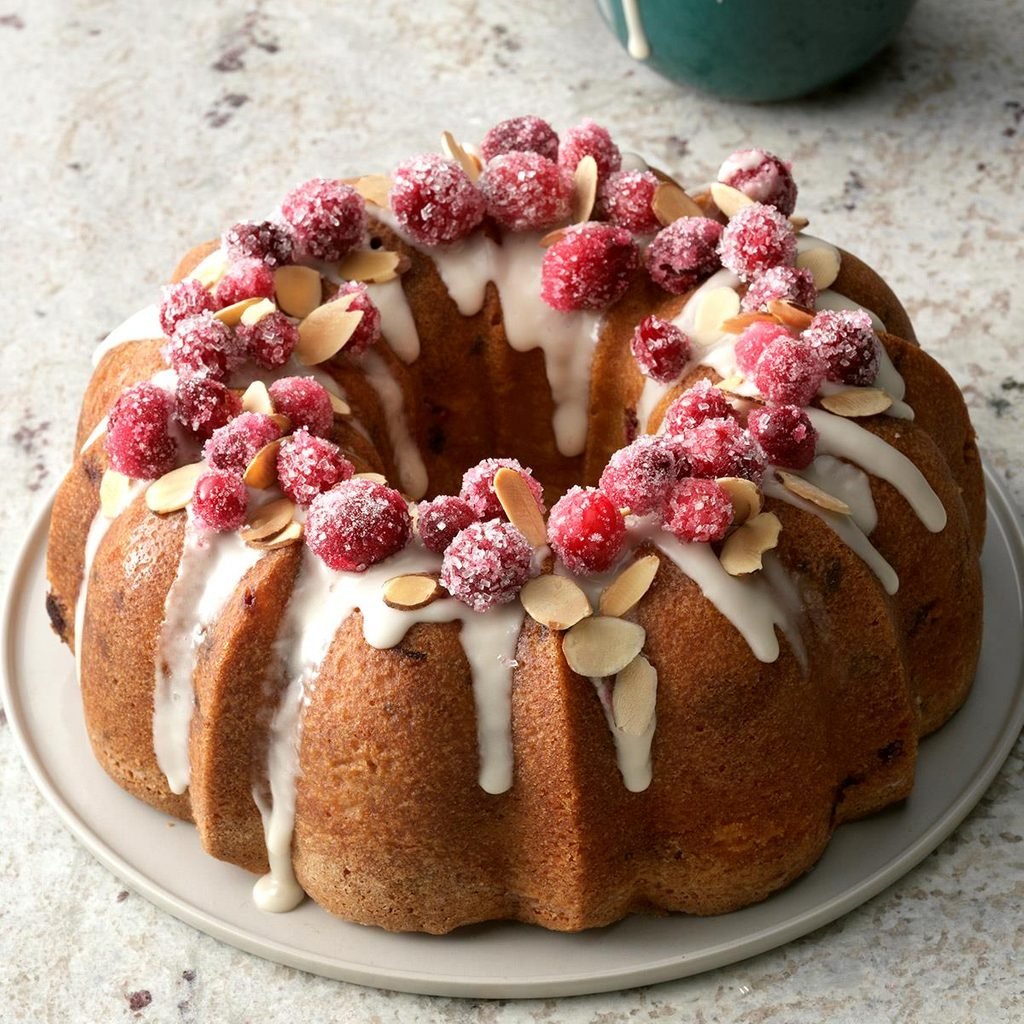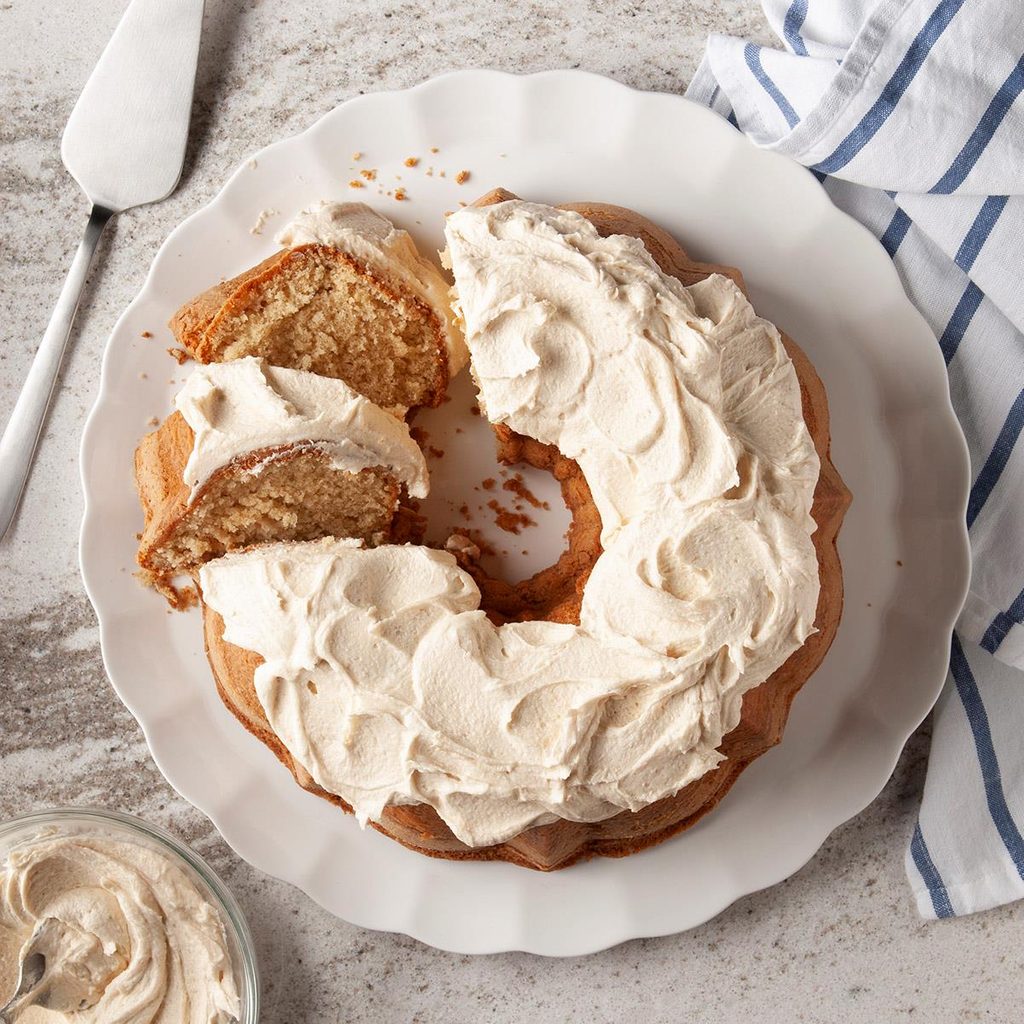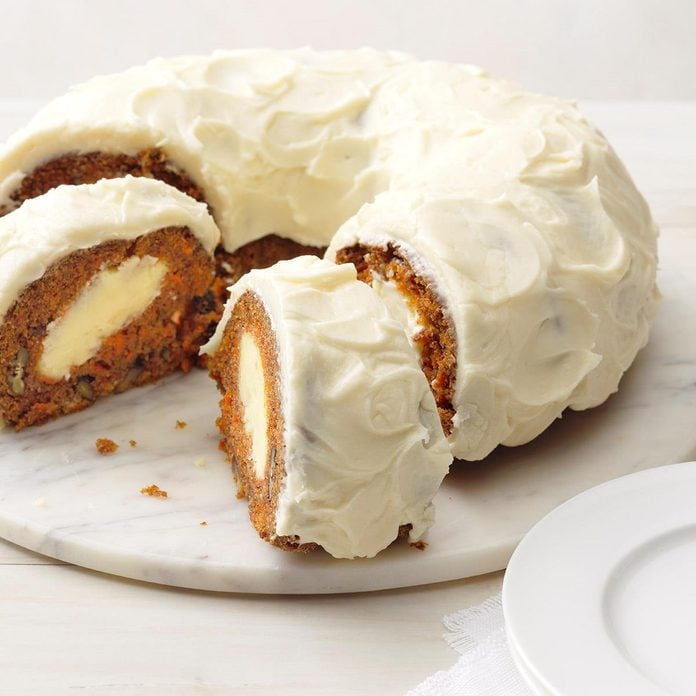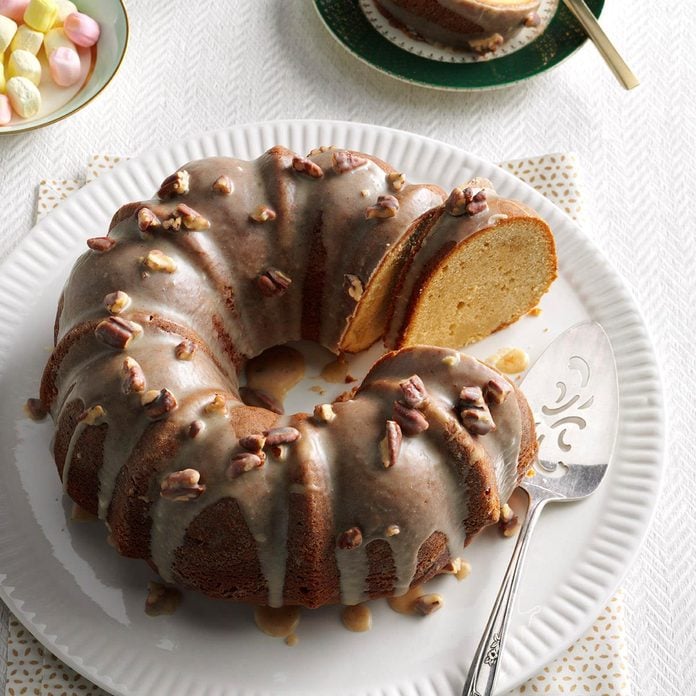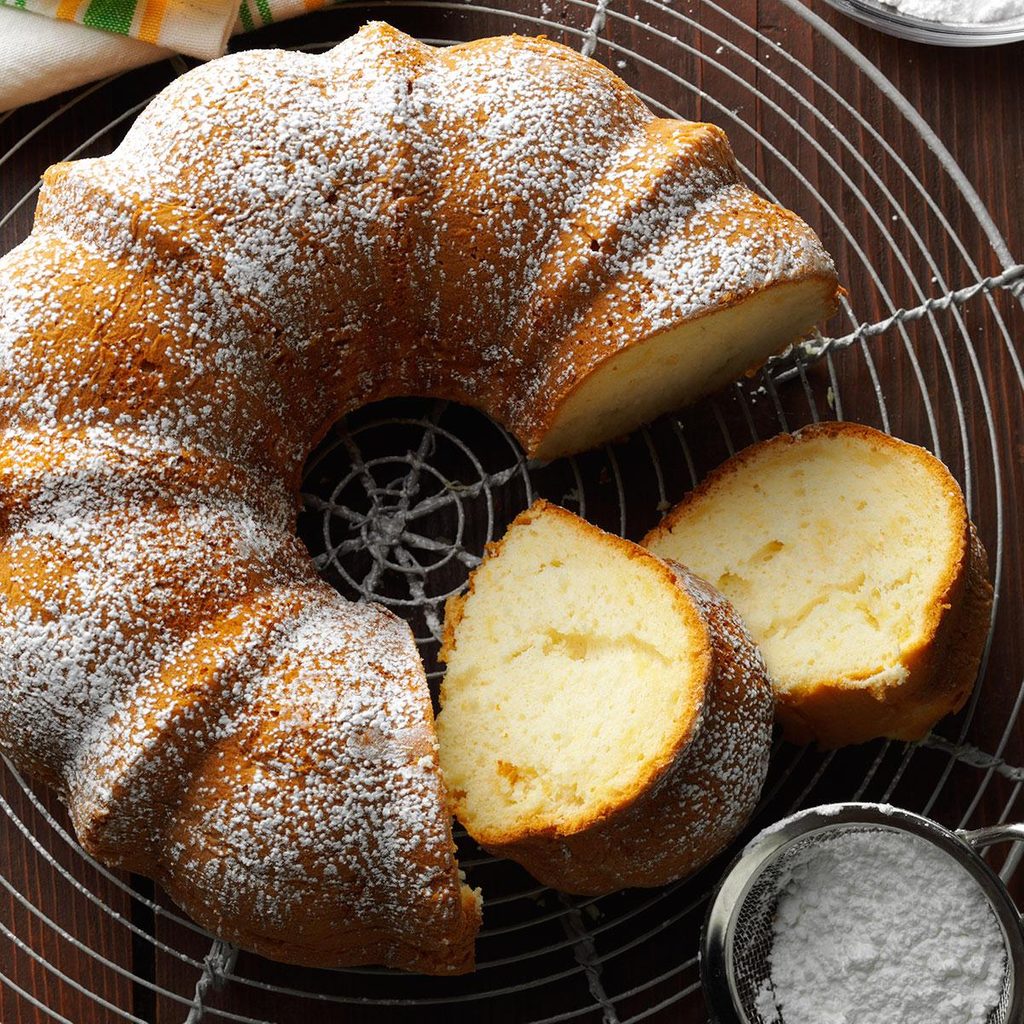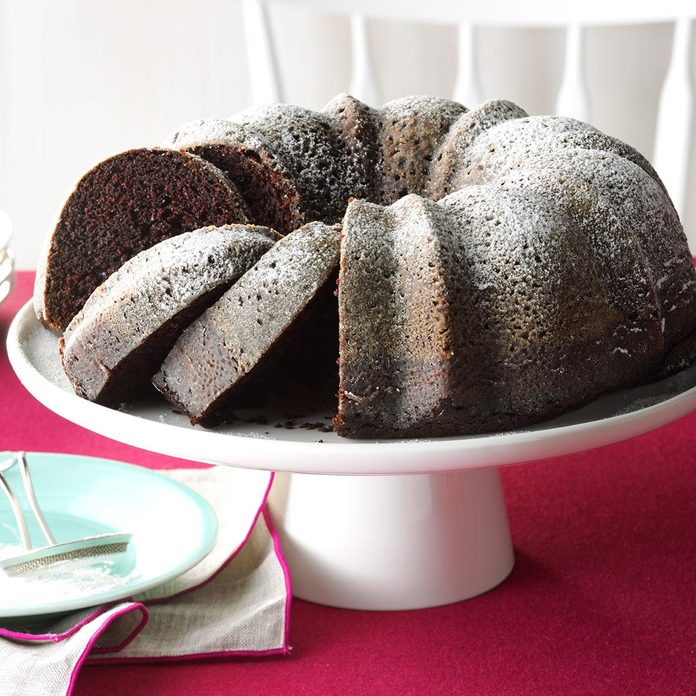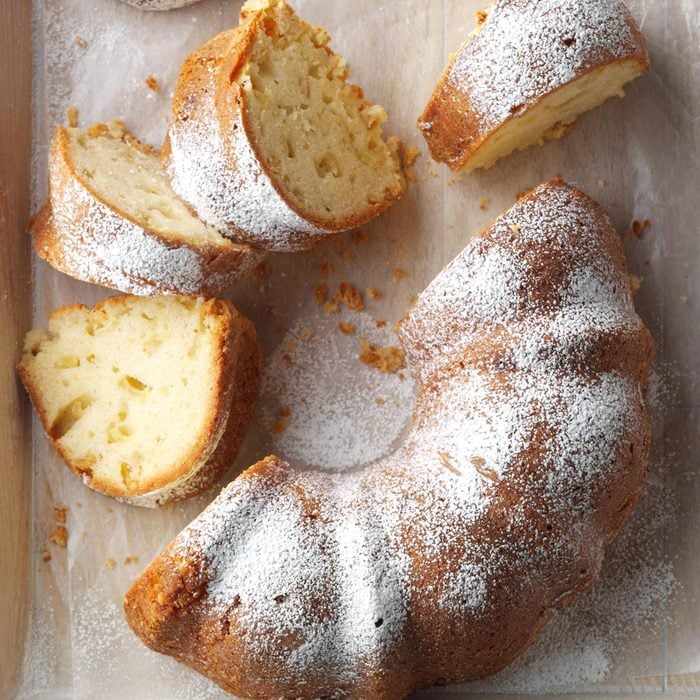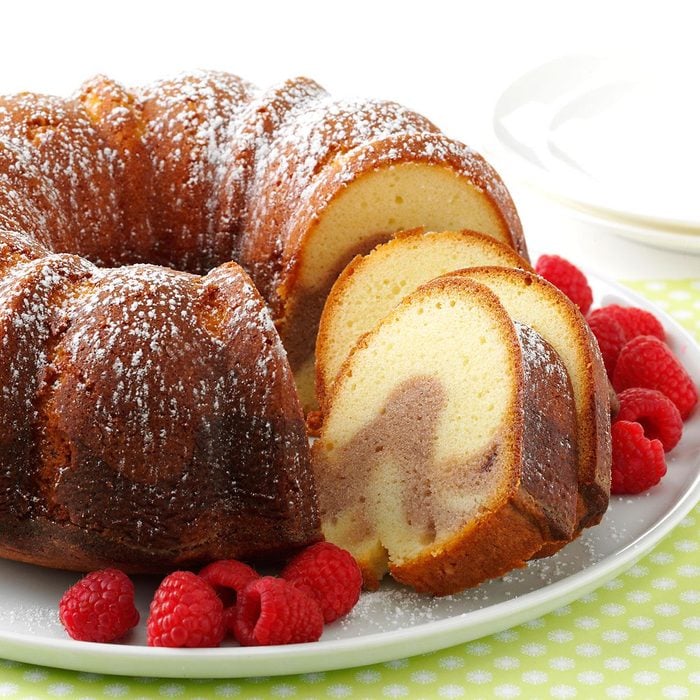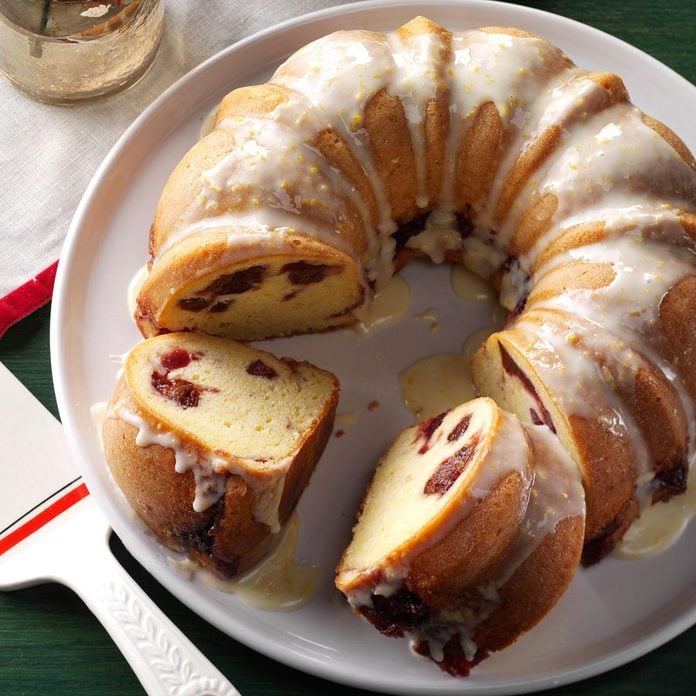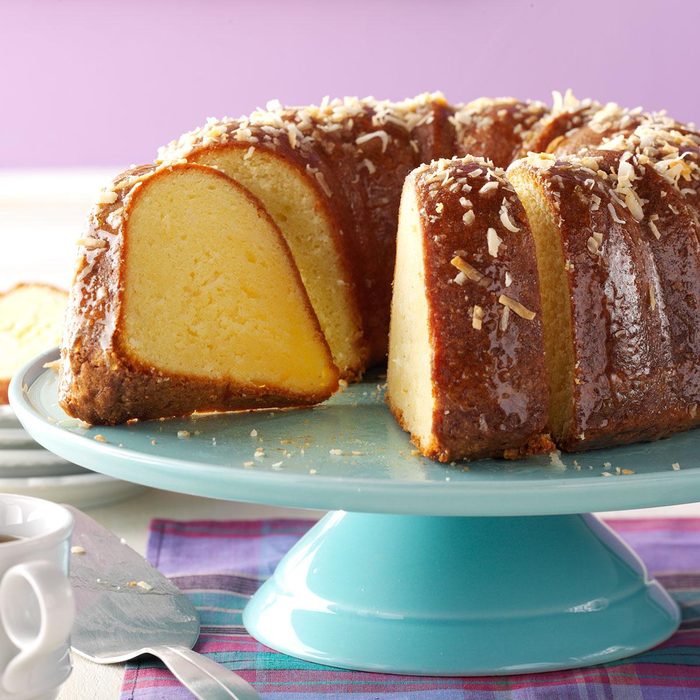With so many pretty Bundt pans out there, it’s easy to want to bake a Bundt cake every day of the week. But sometimes the cake you’re craving isn’t specifically formulated to bake in one of these fancy fluted pans. Can you bake a regular cake in a Bundt pan?
To answer this question (and many more), we got Test Kitchen pro and expert baker Mark Neufang on the case.
Can You Make a Regular Cake in a Bundt Pan?
 TMB Studio
TMB Studio
Good news here: You can definitely make regular cakes in your favorite Bundt pan. According to Mark, you’ll want to stick with recipes for traditional layer cakes, pound cakes and sheet cakes. These all can be baked in your favorite fluted cake pan.
“Cakes that would not work are chiffon cakes or whipped egg white-based cakes,” says Mark. “Additionally, if the cake is a tender one or filled with jams or berries, it may be too delicate to translate to a Bundt pan.”
The bottom line is, if the recipe is not for an angel food cake, chiffon cake or any filled cake, you should be safe converting a regular cake recipe into a Bundt cake recipe.
And yes, you can make Bundt cake recipes in regular cake pans, too! Knowing these baking pan conversions is super handy.
How to Convert a Cake Recipe to a Bundt Cake Recipe
Once you’ve found the non-Bundt recipe you want to bake in a Bundt pan, follow these steps to ensure sweet success.
Directions
Step 1: Review the cake recipe
 TMB Studio
TMB Studio
Carefully read the recipe. Cakes (including boxed mixes) that are baked in a 13×9-inch pan or two 8- or 9-inch round pans make just the right amount of batter for a standard fluted cake pan. If the recipe you’ve got your eyes on is for a single square cake pan or loaf pan, you should double the recipe to fit a deeper Bundt pan, according to Mark.
Step 2: Choose your pan wisely
 TMB Studio
TMB Studio
If you’re starting with a recipe that wasn’t specifically formulated for this type of pan, you may want to avoid using the most intricately etched Bundt in your collection. Choose a Bundt pan that’s a bit more streamlined in its design.
Step 3: Grease the pan properly
 Taste of Home
Taste of Home
Learning how to grease a Bundt pan is an invaluable skill for home bakers. It’ll ensure success for any recipe you choose to bake in these decorative pans.
For best results, grease the pan with shortening. Use a paper towel or clean kitchen towel to get into every crevice of the pan. Then dust the inside of the pan with flour and tap away any excess.
This step does take some time, but it will help ensure that the Bundt cake comes out of the pan in one piece.
Step 4: Fill the pan appropriately
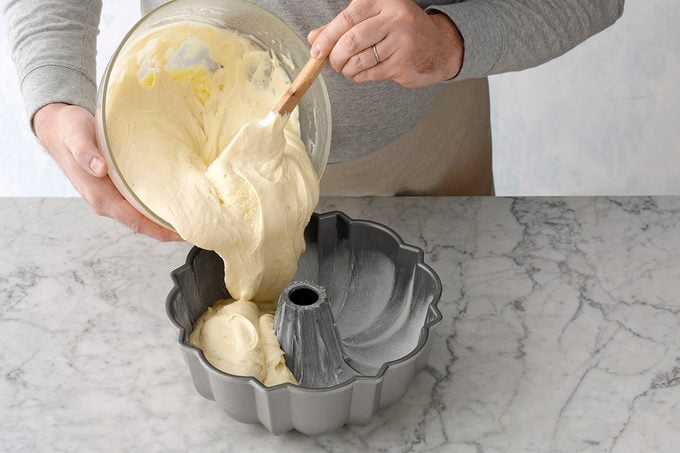 TMB Studio
TMB Studio
The volume of batter of your chosen recipe may not perfectly align with the capacity of a Bundt pan. That’s OK! For best results, fill the pan two-thirds to three-quarters full. Overfilling will create a big mess in your oven, per Mark, so it’s best to hold back extra batter than to overfill the pan.
Editor’s Tip: Don’t toss any leftover batter! You can use it to make a few cupcakes or a small cake in a mini loaf pan. These make great snacks.
Step 5: Adjust the baking time
 Taste of Home
Taste of Home
Because Bundt pans are so deep and hold so much cake, Mark says you will have to lengthen the baking time. The oven temperature does not have to change.
Most Bundt cake recipes are baked for 60 minutes or more. Check for doneness at the 45-minute mark. Use a skewer to pierce the center of the cake. If it comes away clean, the cake is fully baked. If the skewer comes away with cake batter, let it bake for another 5 to 10 minutes and try again.
ⓘ
Now, Bake a Bundt!
With this advice, along with all our other Bundt tips from the Test Kitchen, you’ll be able to create limitless gorgeous cakes (and even use some fun frosting techniques just for these special cakes). Check out some of our top-rated recipes below!
Lemon Lover’s Pound Cake
Everyone raves about this pretty lemon sour cream pound cake—and it sure doesn't last long with my family. It also freezes beautifully, so why not make two and pop one into the freezer for another day? —Annettia Mounger, Kansas City, Missouri
Go to Recipe
Cherry Chocolate Marble CakeCherries and chocolate are natural partners that make desserts such as this simply scrumptious! The marbled effect is easily achieved by layering the two contrasting batters. —Sandra Campbell, Chase Mills, New York
Olive Oil CakeA good olive oil cake isn't overly sweet, so it can just as easily be a breakfast treat or an afternoon snack as a dessert. —Lisa Kaminski, Wauwatosa, Wisconsin
Chocolate Comfort CakeThis moist and delicious chocolate cake is usually the first dessert to go. People even eat the crumbs. It’s always my top choice for holiday dinners. —Ellen Riley, Murfreesboro, Tennessee
Raspberry Moscow Mule CakeThis Moscow mule cake is my favorite cake I've ever made from scratch. It's so moist and flavorful, and it reminds me of my favorite cocktail. —Becky Hardin, St. Peters, Missouri
Blueberries and Cream Coffee CakeThis
blueberry coffee cake is my go-to recipe for all of our holiday get-togethers because it's perfect for breakfast or dessert. It's easy to make, and it's the most delicious coffee cake I've ever had. —Susan Ober, Franconia, New Hampshire
Key Lime Pound CakeThis Key lime pound cake was inspired from a basic pound cake recipe that I like to play around with. It's now the only cake requested at every gathering. The unfrosted cake freezes well. —Pat Stewart, Canton, Georgia
Buttermilk Cake with Caramel IcingThis fabulous cake and caramel frosting are so tender, it melts in your mouth. It's been a family favorite since the '70s and it goes over really well at church potluck meals. —Anna Jean Allen, West Liberty, Kentucky
Margarita CakeThis margarita cake is perfect for a picnic on a warm day. You'll be surprised at how closely it tastes like the real thing. These other
margarita dessert recipes are delicious, too. ?—Dawn Lowenstein, Huntingdon Valley, Pennsylvania
Streuseled Zucchini Bundt CakeInspired by an abundance of zucchini, I found a new way to use it up in this spiced and lightly sweet cake. It even won a blue ribbon at our county fair! —Regina Stock, Topeka, Kansas
Purple-Ribbon Pumpkin CakeI belong to a Christmas village collectors' club and we all bring a potluck dish to our monthy meetings. The cake is always a hit. It's one of my family's favorite Thanksgiving desserts, too, and disappears before the pumpkin pie does. —Debby Powers, Ponte Vedra Beach, Florida
Jelly Donut CakeCake. Doughnuts. Now you don't have to choose between the two. Impress your family with this easy jelly-filled cake. Try your best to center the jelly in the middle of the half-filled Bundt pan so that it will not leak out the edges of the cake. —Colleen Delawder, Herndon, Virginia
Citrus-Raspberry Coffee CakeOrange and lemon beautifully complement the raspberry flavor in this dense cake. Add a dusting of confectioners’ sugar for a pretty finishing touch. —Pat Harlow, Cataldo, Idaho
Banana Pound CakeI adapted a basic pound cake recipe from my great-aunt for this treat. It makes a moist cake that pops out of the pan perfectly. —Nancy Zimmerman, Cape May Court House, New Jersey
Ginger-Glazed Lemon BundtTangy ginger, tart lemon and puckery cranberries make this melt-in-your-mouth cake as crisp—and gorgeous—as autumn. —Taste of Home Test Kitchen
Decadent Fudge CakeEveryone loves the rich flavor in this decadent cake made with four types of chocolate. —Anna Hogge, Yorktown, Virginia
Lemon Pound CakeCitrus trees grow abundantly in California, and I'm always looking for new recipes which use the fruit from the orange and lemon trees in my yard. This lemon pound cake is one of my favorites! My mother passed this recipe down to me. —Richard Killeaney, Spring Valley, California
These
fruit Bundt cake recipes are a sweet way to incorporate freshness into your favorite desserts.
Heavenly Praline CakeA moist cake and generous frosting are filled with the fabulous flavor of caramel. The candied pecans are almost a dessert by themselves!—Jennifer Rodriguez, Midland, Texas
Mint Swirl Fudge CakeMint pairs with a silky, mild chocolate flavor for this colorful, beautiful cake that will be the talk of the holiday buffet. —Heidi Kelly, Norwood, Missouri
Blueberry Sour Cream Coffee CakeHoliday breakfasts would not be the same at our house without this delicious coffee cake. Whenever I take it anywhere, everyone raves about it and wants the recipe. —Susan Walschlager, Anderson, Indiana
Cranberry-Almond Pound CakeWhen you want an extra-special dessert for the holidays, it’s hard to beat a seasonal homemade cake. I like to drizzle mine with a simple but elegant glaze flavored with amaretto. —Jackie Howell, Tucson, Arizona
Peanut Butter Bundt CakeThis peanut butter
Bundt cake with frosting is heavenly to me. I use smooth peanut butter, but crunchy would work, too. —Karen Holt, Rock Hill, South Carolina. Learn
how to frost a Bundt cake with three techniques that add flavor, sweetness and an eye-catching finish.
Lemon Poppy Seed CakeThis luscious lemon poppy seed cake recipe uses cake mix and pudding mix for an easy dessert highlighting the classic flavor combination. —Betty Bjarnason, Egbert, ON
Chocolate Almond CakeFluffy white homemade frosting tops this rich chocolate almond cake. Sliced toasted almonds on top add a little crunch. —Sherri Gentry, Dallas, Oregon
Gingerbread with Fig-Walnut SauceI experimented with aniseed this past holiday season and fell in love with the licorice flavor. It really enhances the gingerbread spices and fig sauce in this extraordinary cake. —Shelly Bevington-Fisher, Hermiston, Oregon
Surprise Carrot CakeA cousin gave me this carrot cake recipe. It's a wonderful potluck pleaser with its "surprise" cream cheese center. My husband and our two young children love it, too! —Lisa Bowen, Little Britian, Ontario
Red Velvet Pound CakeThis delicious red velvet pound cake is the perfect combination of flavors. Make sure the cake has cooled before icing it; for extra crunch sprinkle some roasted pecans on top. —Robin Smith, Old Fort, North Carolina
Coconut Fudge Cake“A big piece of this moist cake is a chocolate and coconut devotee's dream," notes Johnnie. "You should see my husband, children and grandkids smile when I serve it.”
Double Chocolate Espresso Pound CakeTwo of my biggest loves in life—chocolate and coffee—come together in this velvety pound cake. Grate some extra chocolate on top and thank me later. —Rachel Bernhard Seis,
Taste of Home Senior Editor
Almond Apricot Coffee CakeThe nutty aroma and delicate fruit flavor make this cake special enough to serve to company. Strawberry or raspberry preserves can be used as a tasty variation. —Sharon Mensing, Greenfield, Iowa
Brown Sugar Pound CakeThis tender pound cake is the first one I mastered. You'll want to eat the browned butter icing by the spoonful. It tastes like pralines. —Shawn Barto, Winter Garden, Florida
Butter Pound CakeWhether garnished with fresh berries and sprigs of rosemary or just served plain, this rich cake is fabulous. It bakes to a beautiful golden brown and it's definitely a keeper! —Edgar Wright, Silver Spring, Maryland
Choco-Scotch Marble CakeThis recipe was given to me many years ago by a friend. Teaming chocolate with butterscotch for a marble cake makes it more flavorful and colorful than the usual chocolate-vanilla combination. This rich family favorite is very moist and keeps well.
-Pam Giammattei, Valatie, New York
Pear Bundt CakeNext time you make cake from a mix, try my easy and delicious recipe. The pears and syrup add sweet flavor and prevent the cake from drying out. And since there's no oil added to the batter, this tender fall-perfect cake is surprisingly low in fat. —Veronica Ross, Columbia Heights, Minnesota. Don't forget to try our favorite
Nothing Bundt Cake recipe.
Streuseled Zucchini Bundt CakeInspired by an abundance of zucchini, I found a new way to use it up in this spiced and lightly sweet cake. It even won a blue ribbon at our county fair! —Regina Stock, Topeka, Kansas
Contest-Winning Moist Chocolate CakeYou don't have to spend a lot of time to serve an elegant and delicious dessert. Just mix up the batter in one bowl, bake and get ready for people to love this moist dark chocolate cake recipe. —Christa Hageman, Telford, Pennsylvania
Ginger-Walnut Tube CakeMy husband, Ken, loves this tube cake with its bits of crystallized ginger. Feel free to drizzle it with a lemony glaze. —Nancy Zimmerman, Cape May Court House, NJ
Pina Colada Tube CakeWe named this a “pina colada” cake because it has coconut, pineapple and rum. It’s a soothing finish at the end of a big spread. —Debra Keil, Owasso, Oklahoma
Aunt Lou's Fresh Apple CakeMy Great-Aunt Lou made a luscious fresh apple cake recipe that became a family tradition. My mom makes it for our annual beach trip to the Outer Banks. —Cristy King, Scott Depot, West Virginia
Buttermilk Pound CakeNow that I've retired from teaching, I have more time to bake. This buttermilk pound cake is the one I make most often. It is a truly southern recipe, and one I think can't be topped—once people taste it, they won't go back to their other recipes with buttermilk. —Gracie Hanchey, De Ridder, Louisiana
Blueberry Sour Cream Coffee CakeHoliday breakfasts would not be the same at our house without this delicious coffee cake. Whenever I take it anywhere, everyone raves about it and wants the recipe. —Susan Walschlager, Anderson, Indiana
Almond Chocolate CakeWhen our son and daughter were teenagers, our house was the hang-out for their whole group of friends. This rich chocolate almond cake was a regular on the menu. —Char Safley, Raleigh, North Carolina
Breakfast Apple CakeBaked in a pretty tube pan and drizzled with icing, this breakfast cake will be a highlight of your holiday menu. I adapted the recipe from one of my grandmother's. —Shaunda Wenger, Nibley, Utah
Raspberry Swirl Pound CakeBake this up when you want to treat your family to something special and sweet. The raspberries and mint add a springtime freshness, too. —Carly Curtin, Ellicott City, Maryland
Easy Pistachio Tube CakeMixes make this light cake easy, and a fluted tube pan gets it holiday party-ready. Go for the pistachios on top—the extra crunch is worth it. —Dina Crowell, Fredericksburg, Virginia
Cranberry-Filled Orange Pound CakeI made this for a holiday dinner with my family. Everyone loved the cran-orange flavor and the sweet glaze drizzled on top. For a fun variation, include 2/3 cup flaked sweetened coconut when adding the orange juice to the batter, and sprinkle the finished cake with toasted coconut. —Patricia Harmon, Baden, Pennsylvania
Fluted Lemon Cake with Fresh FruitThis citrusy, golden-brown cake looks especially beautiful baked in a fancy fluted pan. Serve each slice with a dollop of whipped cream and fresh fruit. —Donna Pochoday, Morristown, New Jersey
Coconut Pound Cake with Lime GlazeThis pound cake is the best! Oven temps will vary, so if the cake is not done after 1 hour and 20 minutes, continue baking in 5-minute intervals. Use fresh, not bottled, lime juice for the glaze. —Jo McFarland, Sterling, Virginia









